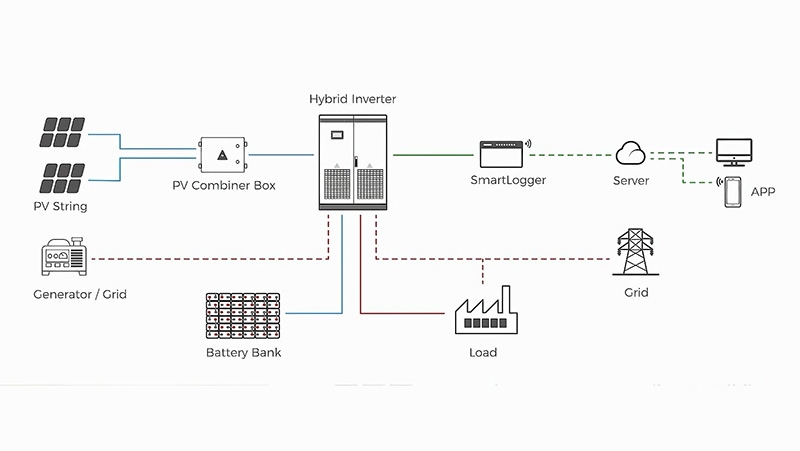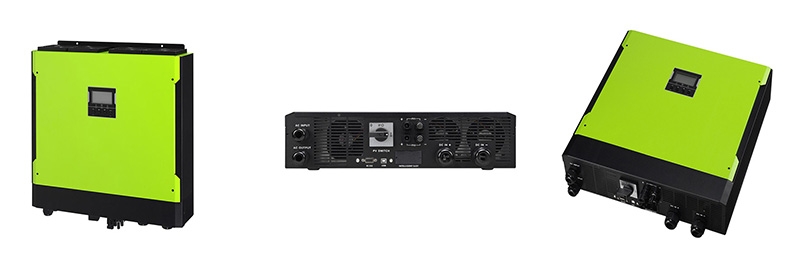In the field of renewable energy, solar energy is one of the most mature and widely used forms of energy. The continuous innovation of its conversion efficiency and utilization methods is the key to promoting the development of the industry. As the core equipment in the solar power generation system, the hybrid solar inverter integrates the functions of the traditional inverter and the energy storage inverter and realizes the two-way conversion and intelligent management of DC to AC. Today Inverter.com will elaborate on the working principle, structural composition, and workflow of the hybrid solar inverter from a professional perspective, and deeply explore its technical details and application value.
What is the working principle of a hybrid solar inverter?
A hybrid solar inverter, referred to as a hybrid inverter, is a comprehensive device that integrates photovoltaic inversion, energy storage inversion, and intelligent management. It can not only convert the DC power generated by solar panels into AC power for household, industrial, and commercial use but also use the power in the energy storage battery to power the load when the power grid is out of power or the light is insufficient, to achieve off-grid operation. In addition, the hybrid inverter also has an intelligent scheduling function, which can automatically adjust the working mode according to the grid status and power demand to achieve the optimal energy configuration.
The working principle of the hybrid solar inverter mainly involves key links such as DC-AC conversion, energy storage management, and intelligent scheduling.
- DC-AC conversion: The most basic function of the hybrid inverter is the DC-AC conversion part. When the DC power generated by the solar panel is input into the inverter, the inverter circuit inside the inverter converts the DC power into AC power by turning on and off the power electronic switch (such as IGBT). This process is usually controlled by PWM (pulse width modulation) technology to ensure the stability and accuracy of the output voltage and frequency.
- Energy storage management: The hybrid inverter has a built-in energy storage management system that can monitor the status of the energy storage battery (such as power, voltage, temperature, etc.) in real-time, and intelligently control the battery charging and discharging process according to the grid status and power demand. When the grid power supply is sufficient and the light is strong, the inverter stores the excess power in the battery; when the grid power outages or there is insufficient light, the inverter automatically switches to battery power supply mode to ensure continuous power supply to the load.
- Intelligent scheduling: The intelligent scheduling function of the hybrid inverter is one of its advanced features. Through the built-in microprocessor and control circuit, the inverter can monitor the grid voltage, current, frequency, and other parameters in real-time, and automatically adjust the working mode according to the preset scheduling strategy. For example, during peak power consumption, the inverter can release the power in the battery to the grid to reduce the pressure on the grid; during low power consumption, the excess power can be stored in the battery for emergency use.
What are the structural components of a hybrid solar inverter?
A hybrid solar inverter usually consists of the following main parts: DC input part, DC/DC converter, inverter, energy storage battery, control part, and AC output.
- DC input part: The DC input part is mainly responsible for receiving the DC power generated by the solar panel. This part usually consists of a DC switch, input filter, input fuse, and MPP (maximum power point) tracker. The MPP tracker can monitor the output voltage and current of the solar panel in real-time, and adjust its working point to keep the solar panel at the maximum power output state.
- DC/DC converter: The DC/DC converter is used to convert the DC input voltage to the DC voltage required by the inverter. This process helps to optimize the input voltage range of the inverter and improve the inverter efficiency. The DC/DC converter usually consists of an output port, an input port, a conversion panel, and a control circuit.
- Inverter part: The inverter part is the core of the hybrid inverter and is responsible for converting DC power to AC power. This part usually consists of an inverter chip, an output filter, an output fuse, and the like. The inverter chip is the core component of the inverter circuit. It realizes the conversion from DC to AC by controlling the on and off of the power electronic switch. The output filter is used to filter out the harmonics and noise generated during the inverter process to ensure the purity and stability of the output voltage.
- Energy storage battery: The energy storage battery is an important component of the hybrid inverter and is used to store excess power for emergency use. The selection of energy storage batteries should be based on actual needs. Common battery types include lead-acid batteries, lithium-ion batteries, etc. The management system of the energy storage battery is responsible for monitoring the battery status, controlling the charging and discharging process, and ensuring the safe and reliable operation of the battery.
- Control part: The control part is the "brain" of the hybrid inverter and is responsible for the monitoring, control, and management of the entire system. This part is usually composed of a microprocessor, a control circuit, a protection circuit, and a display screen. The microprocessor is the core component of the control part. It receives data from sensors and input signals, performs real-time processing and decision-making, and controls the operating status of the inverter. The control circuit is responsible for implementing specific control logic and algorithms. The solar charge controller manages the charging and discharging of the batteries, ensuring optimal battery health and performance. The protection circuit is used to monitor the working status of the inverter. Once an abnormal situation (such as overcurrent, overvoltage, short circuit, etc.) is found, the power supply is immediately cut off to protect the safety of the equipment. The display screen is used to display the operating status and parameter information of the inverter, which is convenient for users to monitor and manage.
- AC output: The AC output part is responsible for supplying the AC power output by the inverter to the load or the power grid. This part is usually composed of output ports, modules, transformers, and output filters. The output port is used to connect the load or the power grid; the module is used to achieve precise control of voltage, current, and frequency; the transformer is used to achieve voltage rise and fall conversion to meet the needs of different loads or power grids; the output filter further filters out the harmonics and noise in the AC power to ensure the quality of the output power.
What is the working process of a hybrid solar inverter?
The workflow of hybrid solar inverters can be summarised in the following stages:
1. Start-up and self-test: When the hybrid inverter is connected to the power supply, it first carries out the start-up and self-test of the system. At this stage, the inverter will check whether each component (such as DC input, DC/DC converter, inverter chip, energy storage battery, control circuit, etc.) is working properly and confirm that there are no faults or abnormalities. After passing the self-test, the inverter enters the standby state and waits for further commands.
2. Maximum Power Point Tracking (MPPT): After entering the working state, the inverter will start the MPPT function to monitor the output voltage and current of the solar panel in real-time. Adjusting the operating point of the solar panels keeps them in the maximum power output state all the time. This process helps to maximize the use of solar energy resources and improve power generation efficiency.
3. DC-AC conversion: Under the MPPT function, the DC power generated by the solar panel is output to the inverter at maximum power. The inverter circuit inside the inverter converts the DC power to AC power through PWM technology. At the same time, the inverter will adjust the output voltage and frequency according to the grid's voltage, frequency, and other parameters to ensure matching with the grid or load.

4. Energy storage management: During the conversion process, the inverter will monitor the status of the energy storage battery and the power supply of the grid in real-time. When the power supply from the grid is sufficient and the light is strong, the inverter will store the excess power in the battery; when the power supply from the grid is out or the light is insufficient, the inverter will automatically switch to the battery power mode to ensure continuous power supply to the load. In addition, the inverter will intelligently control the charging and discharging process of the battery according to the preset scheduling strategy to achieve the optimal allocation of energy.
5. Intelligent scheduling and grid/off-grid switching: The hybrid inverter is equipped with an intelligent scheduling function, which monitors the status of the grid and the demand for electricity in real time. In the grid-connected mode, the inverter will adjust the output power according to the grid's voltage, current, and other parameters to achieve synchronous operation with the grid. When there is a fault or blackout in the grid, the inverter will automatically switch to off-grid mode and use the energy storage battery to supply power to the load. At the same time, the hybrid inverter can also interact with an off-grid inverter to realize peak shaving and valley filling according to the fluctuation of the power grid to reduce the pressure on the power grid.
6. Monitoring and protection: During the whole working process, the inverter will constantly monitor its own operation status and grid parameters. Once abnormal conditions (such as over-current, over-voltage, short-circuit, over-charging or over-discharging of batteries, etc.) are found, the inverter will immediately cut off the power supply and send out alarm signals to protect the safety of equipment and loads. In addition, the inverter is also equipped with a fault diagnosis and recording function, which makes it convenient for users to carry out troubleshooting and maintenance.
As one of the core devices in a solar power system, hybrid solar inverters are highly efficient, intelligent, and reliable, making them widely used in a variety of fields, such as domestic, industrial, and commercial. With the continuous advancement of technology and further cost reduction, hybrid inverters are expected to play an important role in more fields, promoting the popularisation and sustainable development of renewable energy. Home Power Inverter online store offers hybrid solar inverters with power ratings from 3 kW to 10 kW. Please contact us if you have any questions. In the future, we can expect hybrid inverters to achieve more innovations and breakthroughs in intelligent scheduling, energy storage management, fault diagnosis, etc., contributing more to the use of renewable energy and the stable operation of power systems.

